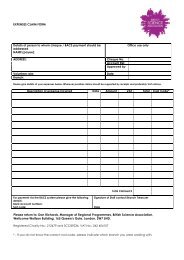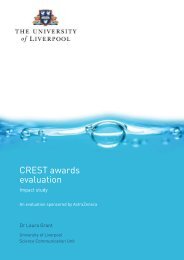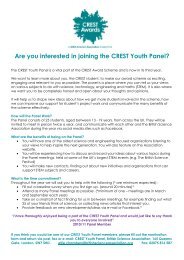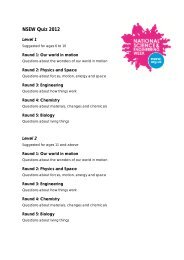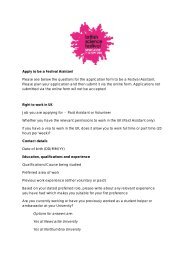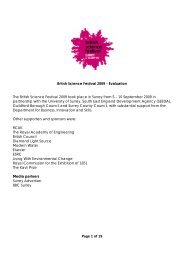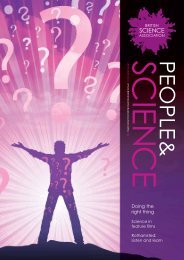CREST Bronze Award â typically 10 hours of project work
CREST Bronze Award â typically 10 hours of project work
CREST Bronze Award â typically 10 hours of project work
You also want an ePaper? Increase the reach of your titles
YUMPU automatically turns print PDFs into web optimized ePapers that Google loves.
Food & Drink: Tea <strong>CREST</strong> <strong>Award</strong>s <strong>project</strong><br />
<strong>CREST</strong> <strong>Bronze</strong> <strong>Award</strong> – <strong>typically</strong> <strong>10</strong> <strong>hours</strong> <strong>of</strong> <strong>project</strong> <strong>work</strong><br />
Make the perfect cup <strong>of</strong> tea<br />
Most people know how to make a cup <strong>of</strong> tea. But not everyone makes it exactly the same<br />
way. In this <strong>project</strong> you can carry out some experiments to <strong>work</strong> out how to make the<br />
perfect cup <strong>of</strong> tea for you. Then you‟ll write a standard procedure (a set <strong>of</strong> really detailed<br />
instructions) so that other people can make tea just how you like it.<br />
There are lots <strong>of</strong> things to think about when making a cup <strong>of</strong> tea. These include:<br />
How much water should you use, and how hot should it be?<br />
How much tea should you use?<br />
Will you use tea bags, or loose tea?<br />
How much milk will you use, and will you put it in before or after the water?<br />
What sort <strong>of</strong> milk will you use: full fat, semi-skimmed or skimmed?<br />
How long should you leave the tea bag (or tea leaves) in the cup?<br />
Do you want sugar? How much?<br />
Setting up some experiments<br />
Any results will depend on your own personal taste. But you can still carry out some fair<br />
tests to decide how best you like your tea. All the things listed above are variables. If you<br />
keep them all the same, but change one, you can <strong>work</strong> out what you prefer. For<br />
example:<br />
Make three cups <strong>of</strong> tea keeping all these things the same:<br />
the amount <strong>of</strong> water<br />
the type and amount <strong>of</strong> milk (and whether you put it in before or after the water)<br />
the same number and type <strong>of</strong> tea bag (and the length <strong>of</strong> time you leave it in the cup)<br />
Use three different temperatures <strong>of</strong> water (for example, one cup with 50 o C, one with 75<br />
o<br />
C and one with <strong>10</strong>0 o C). By tasting each cup you can decide which temperature <strong>of</strong><br />
water to use for your perfect cup <strong>of</strong> tea. Do lots more experiments, but keep different<br />
variables the same, and change others. After each experiment you should write down<br />
your preference.<br />
Instructions on how to make the perfect cuppa<br />
Now you‟ve decided on all your personal variables you can write a standard procedure.<br />
This is a set <strong>of</strong> really detailed instructions (a bit like a recipe) so people can make tea<br />
exactly how you want them to.<br />
For further information visit our website www.britishscienceassociation.org/crest
Food & Drink: Tea <strong>CREST</strong> <strong>Award</strong>s <strong>project</strong><br />
<strong>CREST</strong> Silver <strong>Award</strong> – <strong>typically</strong> 30 <strong>hours</strong> <strong>of</strong> <strong>project</strong> <strong>work</strong><br />
Design and make a quick-brew tea bag<br />
Start by having a look round the shops at all the different types <strong>of</strong> tea bags that are<br />
available. Have a look at the range <strong>of</strong> different shapes and sizes. Carry out some research<br />
into how tea bags are made – perhaps you could contact a tea bag manufacturer for<br />
some help. They may also be able to tell you how their tea bags are tested in industry.<br />
Research what happens between when tea leaves are picked, and when tea bags land<br />
on our supermarket shelves. Find out if there are different processes for different types <strong>of</strong><br />
tea.<br />
Designing your bag<br />
Decide how much tea should be in each bag. You could do this by taking the tea from a<br />
variety <strong>of</strong> tea bags and <strong>work</strong>ing out the average volume <strong>of</strong> tea.<br />
The material<br />
You need to think about what properties the material should have. You may want to<br />
design some tests to check the materials‟ suitability. For example:<br />
you need something porous so the tea will dissipate through the water (you could try<br />
to actually measure porosity)<br />
it shouldn‟t disintegrate or break easily when wet<br />
it should be non-toxic<br />
A couple <strong>of</strong> suitable examples are muslin and cotton.<br />
You will also have to think about how you will cut and join your materials. You may want<br />
to design some tests to check your joining methods <strong>work</strong>.<br />
The tea tests<br />
When you‟ve picked a range <strong>of</strong> suitable materials, you need to check which one provides<br />
the quickest brew. There are lots <strong>of</strong> things to consider (it has to be a fair test). For example:<br />
Make sure you make the tea bags the same size and shape (a simple design will be<br />
best at this stage – you don‟t want to go sewing fancy shaped-designs when you‟re<br />
just checking the material!)<br />
Make sure you use the same amount and temperature <strong>of</strong> water<br />
Decide whether or not you will stir the tea<br />
How you will decide when the tea has brewed (for example, will you wait until it turns a<br />
certain colour)?<br />
Make sure you use the same type and amount <strong>of</strong> tea leaf in each tea bag (you could<br />
buy a packet <strong>of</strong> loose tea to make sure you‟re using the same type each time)<br />
The shape<br />
The range <strong>of</strong> shapes you test is up to you. You could test the already-available types<br />
(square, round, pyramid, for example) or you could make totally new designs.<br />
Think about the size <strong>of</strong> the tea bag; should it be large, so the tea moves around freely<br />
inside, or should it be small, so the tea is packed tightly within?<br />
When you‟ve designed a few bag shapes (about five should be enough), make the tea<br />
bags using your chosen material. Then carry out the same tests as when you were testing<br />
the materials.<br />
The tea bag<br />
Combine your results and you should have the perfect quick brew tea bag!<br />
For further information visit our website www.britishscienceassociation.org/crest
Food & Drink: Tea <strong>CREST</strong> <strong>Award</strong>s <strong>project</strong><br />
<strong>CREST</strong> Gold <strong>Award</strong> – <strong>typically</strong> 70+ <strong>hours</strong> <strong>of</strong> <strong>project</strong> <strong>work</strong><br />
Investigate tannin, caffeine, fluoride and flavanoid in tea<br />
You‟re going to produce a leaflet entitled: “Everything looks brighter after a cup <strong>of</strong> tea –<br />
Fact or Fiction”. It will explain all the health risks and benefits <strong>of</strong> drinking tea. You will<br />
substantiate any <strong>of</strong> your claims by investigating tannin, caffeine and flavanoids. You will<br />
carry out analytical tests on tea samples. Your leaflet should be able to list a number <strong>of</strong><br />
different types and brands <strong>of</strong> tea with the findings from any tests explained.<br />
Tannin content<br />
Start by looking at the range <strong>of</strong> teas available. Pick a wide selection <strong>of</strong> types to test. First,<br />
you need to do some research to find out what tannin is. Find out what it does to your cup<br />
<strong>of</strong> tea – both in appearance and flavour. Find out if it has any other uses. Does it have any<br />
harmful/beneficial effects on health? Find out if any teas give information about their<br />
tannin levels on the packaging. Design a test to determine which <strong>of</strong> your tea samples<br />
contains the most tannin. When you‟ve got some rough, comparative results, find out how<br />
to determine actual quantities <strong>of</strong> tannin in tea samples. You will need to investigate<br />
protein precipitation and spectroscopy. When you‟re au fait with the method you should<br />
set about determining the tannin levels in your tea samples. You may need to link up with<br />
a university or someone from industry if your school/college doesn‟t have the appropriate<br />
equipment.<br />
Caffeine content<br />
Next up is caffeine. There‟s a lot <strong>of</strong> literature available about why too much caffeine is<br />
bad for us. Conduct your own research and collate your findings. Try also to find out if<br />
caffeine is beneficial in any way. Find out if any teas give information about their caffeine<br />
levels on the packaging. Pick decaffeinated as well as caffeinated teas to test.<br />
Design some tests to see if drinking caffeine can affect performance. Note: only conduct<br />
these tests if you have written permission from the subjects. Work out if it‟s possible to<br />
determine the caffeine levels in your tea samples. You will need to find out about High<br />
Performance Liquid Chromatography (HPLC). You could also determine the caffeine<br />
levels in a variety <strong>of</strong> c<strong>of</strong>fees. Which contains more caffeine, tea or c<strong>of</strong>fee? Note: you will<br />
almost certainly need to link up with a university or someone from industry to use HPLCequipment.<br />
Flavanoid and fluoride content<br />
Tea contains flavanoid, a type <strong>of</strong> polyphenol. Find out about the health benefits <strong>of</strong><br />
flavanoids. Find out if any teas give information about the number/amount <strong>of</strong> flavanoids<br />
on the packaging. It is possible to determine the polyphenol content <strong>of</strong> your tea samples.<br />
However, you won‟t be able to conduct such tests in your school/college (or even a<br />
university); stick to researching the methods. Polyphenols are extracted using 70%<br />
methanol/water solvent. The content is determined by a method called „Folin Ciocalteu<br />
spectrophotometry against gallic acid standards‟. Tea also contains fluoride. Find out the<br />
health benefits/risks <strong>of</strong> fluoride. Find out if any teas give information about the amount <strong>of</strong><br />
fluoride on the packaging. As with flavanoids, determining the content <strong>of</strong> fluorides won‟t<br />
be possible within a school/college. Again, research the methods and, if possible, contact<br />
someone in industry to demonstrate them.<br />
For further information visit our website www.britishscienceassociation.org/crest
Food & Drink: Tea <strong>CREST</strong> <strong>Award</strong>s <strong>project</strong><br />
Health & Safety considerations<br />
When you carry out experiments make sure you:<br />
(a) find out if any <strong>of</strong> the substances used or made, or any <strong>of</strong> the equipment or procedures<br />
are hazardous<br />
(b) carry out a risk assessment (in other words, think about what could go wrong and how<br />
serious it might be)<br />
(c) decide what steps you need to take, if any, to reduce the risks. For example, by<br />
wearing personal protective equipment, being aware <strong>of</strong> how to deal with any<br />
emergencies and so on<br />
(d) make sure your teacher checks your plans and risk assessment before practical <strong>work</strong><br />
starts<br />
(e) if special tools or machines are needed, these should be used in a properly supervised<br />
<strong>work</strong>shop or D&T room.<br />
NOTE: Your teacher will check your risk assessment against that <strong>of</strong> his/her employer (i.e.<br />
your school or LEA). If no risk assessment exists for your activity, your teacher may need to<br />
obtain a special risk assessment (e.g. by contacting the CLEAPPS School Science Service.)<br />
This may take some time.<br />
For further information visit our website www.britishscienceassociation.org/crest




